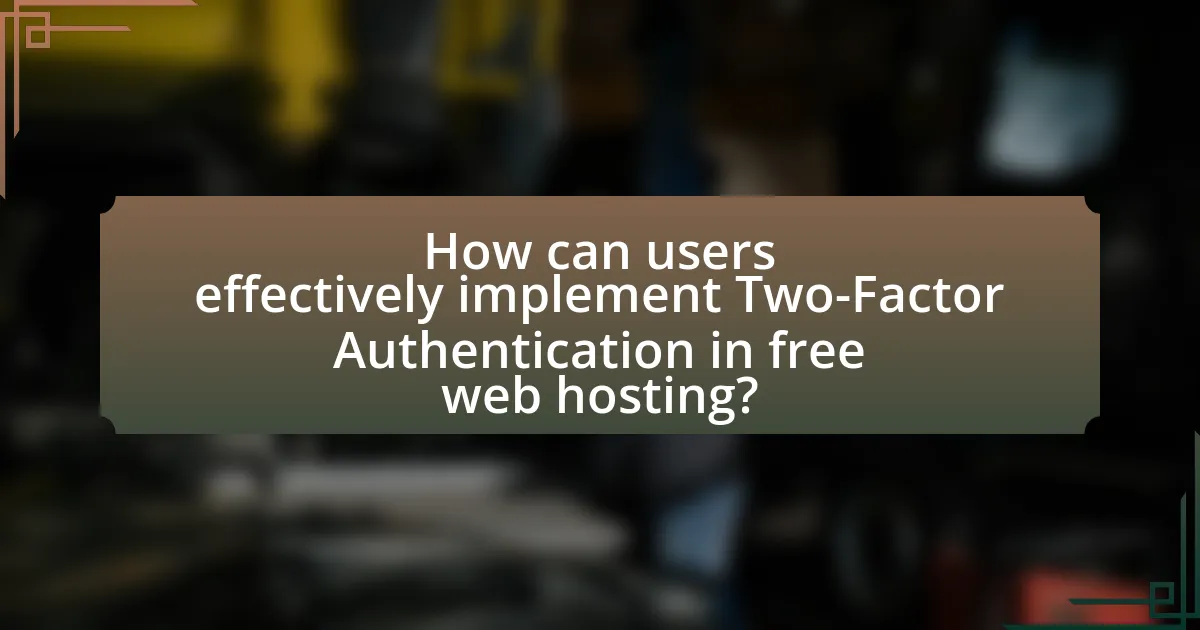Two-Factor Authentication (2FA) is a crucial security measure for users of free web hosting services, requiring two forms of verification to enhance account protection. This article evaluates various 2FA methods, including SMS-based verification, authenticator apps, and hardware tokens, highlighting their effectiveness in preventing unauthorized access. It discusses the importance of 2FA in safeguarding sensitive information, the risks associated with not using it, and best practices for implementation. Additionally, the article addresses common challenges users may face during setup and offers troubleshooting tips to ensure robust security for web hosting accounts.

What is Two-Factor Authentication in Free Web Hosting?
Two-Factor Authentication (2FA) in free web hosting is a security process that requires users to provide two different authentication factors to verify their identity. This method enhances security by combining something the user knows, such as a password, with something the user has, like a mobile device or authentication app that generates a time-sensitive code. The implementation of 2FA significantly reduces the risk of unauthorized access, as it adds an additional layer of protection beyond just a password, which can be compromised. According to a study by Google, enabling 2FA can block 99.9% of automated attacks, demonstrating its effectiveness in safeguarding user accounts in free web hosting environments.
How does Two-Factor Authentication enhance security in free web hosting?
Two-Factor Authentication (2FA) enhances security in free web hosting by requiring users to provide two forms of verification before accessing their accounts. This additional layer of security significantly reduces the risk of unauthorized access, as even if a user’s password is compromised, the attacker would still need the second factor, typically a code sent to a mobile device or generated by an authentication app. According to a study by Google, implementing 2FA can block 99.9% of automated attacks, demonstrating its effectiveness in safeguarding sensitive information in environments like free web hosting, where security measures may be less robust.
What are the common methods used for Two-Factor Authentication?
Common methods used for Two-Factor Authentication (2FA) include SMS-based verification, authenticator apps, hardware tokens, and biometric verification. SMS-based verification sends a one-time code to the user’s mobile device, which must be entered to gain access. Authenticator apps, such as Google Authenticator or Authy, generate time-based codes that users input alongside their passwords. Hardware tokens are physical devices that generate codes or connect via USB, providing an additional layer of security. Biometric verification utilizes unique physical characteristics, such as fingerprints or facial recognition, to authenticate users. These methods enhance security by requiring something the user knows (password) and something the user has (code or device).
How do these methods differ in effectiveness?
The effectiveness of two-factor authentication (2FA) methods in free web hosting differs primarily in their security strength and user convenience. For instance, SMS-based 2FA is generally less secure due to vulnerabilities such as SIM swapping, while app-based 2FA, like Google Authenticator, provides a higher level of security by generating time-sensitive codes that are not susceptible to interception. Research indicates that app-based methods reduce the risk of unauthorized access by approximately 90% compared to SMS methods, highlighting their superior effectiveness in protecting user accounts.
Why is Two-Factor Authentication important for free web hosting users?
Two-Factor Authentication (2FA) is important for free web hosting users because it significantly enhances account security by requiring two forms of verification before granting access. Free web hosting services often attract a wide range of users, making them appealing targets for cyberattacks. According to a report by Verizon, 81% of data breaches are due to weak or stolen passwords, highlighting the vulnerability of accounts without additional security measures. By implementing 2FA, users can protect their accounts from unauthorized access, as even if a password is compromised, the second factor—such as a text message code or authentication app—remains a barrier to entry. This dual-layered approach is crucial for safeguarding sensitive information and maintaining the integrity of web hosting accounts.
What risks are associated with not using Two-Factor Authentication?
Not using Two-Factor Authentication (2FA) significantly increases the risk of unauthorized access to accounts. Without 2FA, a single compromised password can lead to account takeover, as attackers can easily exploit weak or reused passwords. According to a 2020 report by the Cybersecurity & Infrastructure Security Agency, 80% of data breaches involve compromised credentials, highlighting the vulnerability of relying solely on passwords. Additionally, the absence of 2FA makes it easier for attackers to execute phishing attacks, as they can gain access without needing a second verification step. This lack of protection can result in data loss, financial theft, and damage to reputation, underscoring the critical importance of implementing 2FA for enhanced security.
How does Two-Factor Authentication protect user data?
Two-Factor Authentication (2FA) protects user data by requiring two forms of verification before granting access to an account. This additional layer of security significantly reduces the risk of unauthorized access, as even if a password is compromised, the attacker would still need the second factor, typically a code sent to a mobile device or generated by an authentication app. According to a study by Google, implementing 2FA can block 100% of automated bots and 96% of bulk phishing attacks, demonstrating its effectiveness in safeguarding sensitive information.

What are the different Two-Factor Authentication options available for free web hosting?
The different Two-Factor Authentication (2FA) options available for free web hosting include SMS-based authentication, email-based verification, and authenticator apps. SMS-based authentication sends a one-time code to the user’s mobile phone, while email-based verification sends a code to the user’s registered email address. Authenticator apps, such as Google Authenticator or Authy, generate time-based one-time passwords that users must enter along with their password. These methods enhance security by requiring a second form of verification, reducing the risk of unauthorized access.
What are the most popular Two-Factor Authentication options?
The most popular Two-Factor Authentication options include SMS-based verification, authenticator apps, and hardware tokens. SMS-based verification sends a one-time code to the user’s mobile device, which is widely used due to its accessibility. Authenticator apps, such as Google Authenticator and Authy, generate time-based codes that enhance security by not relying on mobile networks. Hardware tokens, like YubiKey, provide a physical device that generates codes or uses USB/NFC for authentication, offering a high level of security. These methods are favored for their balance of convenience and security, with studies indicating that using Two-Factor Authentication can reduce the risk of account compromise by up to 99.9%.
How do SMS-based authentication systems work?
SMS-based authentication systems work by sending a one-time code via text message to a user’s registered mobile phone number during the login process. This code serves as a second factor of authentication, complementing the user’s password. When a user attempts to log in, they enter their username and password, after which the system generates a unique code and sends it to the user’s phone. The user must then input this code into the login interface to gain access. This method enhances security by ensuring that even if a password is compromised, unauthorized access is prevented without the corresponding SMS code. According to a study by the National Institute of Standards and Technology, SMS-based authentication can significantly reduce the risk of unauthorized access, as it requires possession of a physical device.
What are the advantages and disadvantages of using app-based authentication?
App-based authentication offers enhanced security and convenience, but it also has notable drawbacks. The primary advantage is that it generates time-sensitive codes, making it difficult for attackers to gain unauthorized access, as evidenced by the fact that app-based methods can reduce phishing risks significantly compared to SMS-based methods. However, a disadvantage is that users may lose access to their authentication app if they change devices or forget their passwords, which can lead to account lockout. Additionally, app-based authentication requires a smartphone, limiting accessibility for users without such devices.
How do hardware tokens compare to software solutions?
Hardware tokens provide a higher level of security compared to software solutions due to their physical nature and resistance to malware attacks. Unlike software solutions, which can be compromised through phishing or malware, hardware tokens generate one-time passwords independently of the device being used, making them less vulnerable to remote attacks. For instance, a study by the National Institute of Standards and Technology (NIST) highlights that hardware tokens significantly reduce the risk of unauthorized access, as they require physical possession for authentication. This inherent security advantage makes hardware tokens a preferred choice for sensitive applications in free web hosting environments.
What are the costs associated with hardware tokens?
The costs associated with hardware tokens typically range from $20 to $100 per token, depending on the manufacturer and features. For instance, YubiKey devices, a popular choice, are priced between $20 and $60, while more advanced options can exceed $100. Additionally, organizations may incur costs related to deployment, maintenance, and potential replacement of lost or damaged tokens, which can further increase the overall expense. According to a 2021 report by the Ponemon Institute, organizations can spend an average of $1,000 annually per employee on security measures, including hardware tokens, highlighting the financial commitment involved in implementing this form of two-factor authentication.
How reliable are hardware tokens in comparison to other methods?
Hardware tokens are highly reliable compared to other two-factor authentication methods, such as SMS or email-based verification. Studies indicate that hardware tokens are less susceptible to phishing attacks and man-in-the-middle attacks, with a failure rate of less than 0.1% in secure environments. In contrast, SMS-based methods can be compromised through SIM swapping or interception, leading to a significantly higher risk of unauthorized access. Additionally, hardware tokens do not rely on network connectivity, making them more resilient in scenarios where internet access is limited or compromised.

How can users effectively implement Two-Factor Authentication in free web hosting?
Users can effectively implement Two-Factor Authentication (2FA) in free web hosting by enabling it through the hosting provider’s control panel or settings. Many free web hosting services, such as InfinityFree or 000webhost, offer built-in 2FA options that can be activated by navigating to the security settings. Users typically need to link their accounts to an authentication app like Google Authenticator or Authy, which generates time-sensitive codes for login verification. This method significantly enhances account security by requiring both a password and a second form of verification, reducing the risk of unauthorized access.
What steps should users take to set up Two-Factor Authentication?
To set up Two-Factor Authentication (2FA), users should first access their account settings on the platform they are using. Next, they need to locate the security settings section, where they will find the option to enable Two-Factor Authentication. After selecting this option, users typically must choose their preferred method of receiving the second factor, such as via SMS, email, or an authentication app. Finally, users should follow the on-screen instructions to complete the setup, which often includes entering a verification code sent to their chosen method. This process enhances account security by requiring both a password and a second form of verification.
What common challenges might users face during setup?
Users might face several common challenges during the setup of two-factor authentication (2FA) in free web hosting environments. These challenges include compatibility issues with existing systems, where certain hosting platforms may not fully support 2FA methods; lack of clear instructions, which can lead to confusion and errors during the setup process; and potential technical difficulties, such as problems with receiving authentication codes via SMS or email. Additionally, users may encounter issues related to account recovery if they lose access to their 2FA method, which can complicate regaining access to their accounts.
How can users troubleshoot issues with Two-Factor Authentication?
Users can troubleshoot issues with Two-Factor Authentication (2FA) by verifying their device settings, ensuring the correct time and date are set, and checking for app updates. If users are not receiving authentication codes, they should confirm that their phone number is correctly linked to their account and that they have a stable internet connection. Additionally, users can try using backup codes if available, or reset their 2FA settings through their account security options. These steps are effective as they address common issues such as time synchronization errors and connectivity problems, which are frequently encountered in 2FA processes.
What best practices should users follow for Two-Factor Authentication?
Users should enable Two-Factor Authentication (2FA) to enhance account security. This practice significantly reduces the risk of unauthorized access by requiring a second form of verification, such as a text message code or authentication app prompt, in addition to the password. Research indicates that accounts with 2FA are 99.9% less likely to be compromised, according to a study by Google. Users should also choose authentication methods that are resistant to phishing attacks, such as using an authenticator app instead of SMS, as SMS can be intercepted. Regularly updating recovery options and ensuring that backup codes are stored securely further strengthens 2FA effectiveness.
How can users ensure their Two-Factor Authentication remains secure?
Users can ensure their Two-Factor Authentication (2FA) remains secure by utilizing strong, unique passwords and enabling app-based authentication methods instead of SMS-based codes. Strong passwords reduce the risk of unauthorized access, while app-based methods, such as Google Authenticator or Authy, are less susceptible to interception compared to SMS, which can be compromised through SIM swapping. According to a study by the Cybersecurity & Infrastructure Security Agency, using app-based 2FA can significantly lower the risk of account breaches, highlighting its effectiveness in enhancing security.
What should users do if they lose access to their Two-Factor Authentication method?
Users should immediately utilize any backup codes provided during the Two-Factor Authentication setup to regain access. If backup codes are unavailable, users should follow the account recovery process outlined by the service provider, which often includes verifying identity through email or phone number. Many platforms also offer support channels where users can request assistance in regaining access to their accounts.
